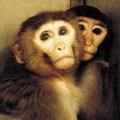 我們發現,最令人憂慮的事情就是,即使有實驗用動物的照顧指導手冊,但不管是身為主管的美國農業部,或著有動物實驗的大學及醫學中心,都很少照著指導手冊執行。許多習慣於每天遊盪幾英哩的動物,譬如猴子,如今卻被關在只能勉強轉身的籠子裡。
我們發現,最令人憂慮的事情就是,即使有實驗用動物的照顧指導手冊,但不管是身為主管的美國農業部,或著有動物實驗的大學及醫學中心,都很少照著指導手冊執行。許多習慣於每天遊盪幾英哩的動物,譬如猴子,如今卻被關在只能勉強轉身的籠子裡。
那些最有力的動物研究遊說者,也正是這類指導手冊的主要資助者。
下一個最令人憂慮的迷思是,人們相信所有動物實驗的結果,都可為病人在醫療照護上,帶來非常大的進步。在一些相關的聽證會上,當地的研究團體,便總是帶著坐著輪椅的人們,出來陳述動物實驗是如何地拯救他們的生命。
我們很快地發現,與大眾的認知相反,使用動物的研究計畫,並沒有全國性的協調。因此重覆的研究不斷發生,並且一點也不奇怪看到20個、30,甚至超過100個完全相同的實驗同時在進行。
沒有人在要求研究者彼此互相討論、比較研究結果,更甚者,也沒有人要求研究要有結果。
美國的醫學研究體系中,若研究沒有達到所預期的效果便不會被發表,視為失敗而被摒棄,即使這些結論可能會成為其他研究者寶貴的資料。
 那些寵物所遭受的痛疼及折磨是非常可怕的。我在動物基金會時,曾問過南加大的動物研究實驗室負責人,為何使用動物做為研究對象?他回答說:「因為牠們跟人類是如此地相似。」
那些寵物所遭受的痛疼及折磨是非常可怕的。我在動物基金會時,曾問過南加大的動物研究實驗室負責人,為何使用動物做為研究對象?他回答說:「因為牠們跟人類是如此地相似。」
隨即我再問道:「但是為什麼,面對牠們所承受的劇痛及折磨,我們甚至沒有能夠給予牠們最起碼的關懷?」「因為他們不像我們。」他回答。
這些以動物為實驗對象的人們希望能兩者兼得,結果是,並無法兩者共得。
重複的研究、缺乏研究結果的分享機制--不論成功或失敗,還有動物的痛苦及折磨,如果這還不夠,就我的經驗來說,還有一個令人震驚的迷思。大家以為,所有的動物實驗都會產生一些治療疾病的結果,事實不然。大部分研究還不夠格發表,縱有發表,離定論也還遠的很。
那些從動物收容所拿來做實驗的狗和貓,其出身背景是完全未知的。沒有血統書及健康記錄,其實驗報告充其量只能作為參考用的。
我們成功說服了洛杉磯市動物的收容所,停止販售動物們給研究機構,但在整個郡乃至於整國國家,我們仍尚未成功。(待續)
The most troubling thing we discovered was that although there are guidelines for the care of animals that are used in research facilities, there is little enforcement, either by the U.S. Department of Agriculture, which has that responsibility, or by the administrations of the universities and medical centers with animal experimentation facilities. Animals used to roaming many miles each day, like monkeys, are routinely, to this day, kept in cages in which they can barely turn around.
The powerful animal research lobby was also the major contributor to those guidelines.
The next most troubling myth we tackled was the belief that all animal experiments are resulting in some great leap forward in medical care and treatment of humans with life threatening diseases. During public hearings on the issue, the local research community always brings wheelchair bound people who would state how their lives had been saved by animal experimentation.
We quickly discovered, though, that contrary to widespread public assumptions, the reality is that there is no national program to properly coordinate the research projects that use animals. Hence, duplication of efforts are rampant, and it is not unusual to see 20 or 30 or, in some cases, more than 100 of the exact same experiments being conducted at any time.
There is no requirement that these researchers even speak with one another to compare results. There isn’t even a requirement that their research produce any useable results.
And in the U.S. medical research system, results that do not meet the expectations of the researcher are never published. They are considered failures and discarded, even though such information could be invaluable to others who are studying the same problem.
The pain and suffering endured by these former pets is horrendous. During the Fund for Animals campaign, I asked the head of the animal research laboratory at the University of Southern California why they use animals in their research experiments. “Because they are so much like us,” he replied.
I then asked, “But why, then aren’t the animals afforded even the minimum of consideration for the intense pain and suffering they endure?” He replied, “Because they are not like us.”
Those who experiment on animals want it both ways. It turns out, you can’t have it both ways. (to be continued)
全文與圖片詳見:http://www.ens-newswire.com/ens/oct2003/2003-10-10g.asp
版權歸屬Environment News Service (ENS)


